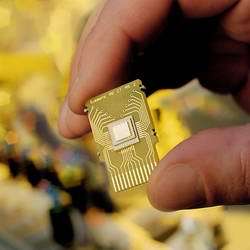Mobile Electronic Devices Learn to Smell

Siemens researchers have succeeded in developing novel mini-sensors that can detect gases and smells. Mobile electronic devices will be used in future to measure the ozone level in the air and warn if it exceeds the limits, or emit a signal in reaction to the smell of burning or leaking gas. A possible application would be a portable warning device for travelers that would wake them up in case of danger when they were asleep.
“We’ve discovered new functional principles and then developed new materials to exploit these principles industrially using all the potential offered by nanotechnology,” says Siemens researcher Dr. Maximilian Fleischer, explaining the concentrated high tech packed onto a tiny area. It takes highly advanced scanning electron microscopes to reveal the structures of the new materials. The tiny sensors developed from these materials can effectively trace even the smallest quantities of gas. “Our ceramic sensor chips are less than a millimeter in size,” states Fleischer. “Although you can barely see them with the naked eye these sensors incorporate a large number of miniaturized functions in which chemical reactions take place.”
Different sensor types have been developed for the different gases. FET gas sensors operate at normal room temperature, whereas metal oxide gas sensors detect the presence and concentration of individual gases as soon as they are heated to several hundred degrees C. The gases react with the sensor material which is combined with silicon technology. This system reads out the chemical changes electronically, amplifies the electronic signal and further processes it. If the sensor material is subsequently exposed to the ambient air again it regenerates itself. These sensors can also be used in contaminated environments. “We have sensors that are extremely stable due to the high local temperatures and can automatically burn off any contamination,” said Fleischer.
Thanks to their small size, low production costs and economical energy consumption – anything between a few 100mW and less than 1mW depending on the design of the sensor – the new gas sensors are of interest for a large number of applications for which no technical solution has existed before. Mobile electronic devices can indicate the ozone level in the air for people doing sports and emit a warning signal if the officially recommended limits are exceeded. Or if you’re out in the evening, the handy device can be used to measure the alcohol level in a person’s breath. The sensors can detect gas leaks in the home, at the work place or when traveling. Another area of application is as a fire detector. “Present day fire detectors measure the temperature or the smoke density,” explained Fleischer. “Our sensor gives a warning before the fire really breaks out. Just like the human nose, it can sense early on if something is smoldering or starting to burn. I’m certain that in future many people will have their own personal warning device at home or take one with them when they travel.”
Source: Siemens
















